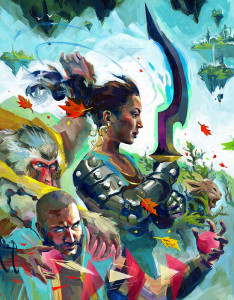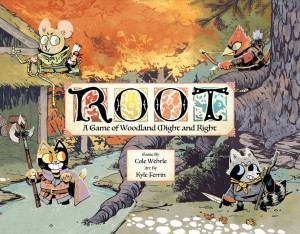Form Complimenting Theme — two new games
I've had some deliveries from Kickstarter recently, including a few that have absolutely floated my boat in terms of both look and mechanics. It's a rare and beautiful thing when a game's theme is comprehensively supported by the way it plays, and I wanted to flag up a couple in case readers who like this sort of thing haven't come across them. These will both be available to the general very shortly, I believe.
 Overlight (RPG) — Renegade Studios
Overlight (RPG) — Renegade Studios
I originally backed this game just because it promised to be absolutely beautiful. Getting the art right is probably the most important thing for anyone crowdfunding a game – good art suggests, at least, a good game, and the pictures are worth the proverbial amount of words when it comes to communicating to potential players what playing that game will feel like.
Overlight is indeed one of the most visually appealing and colourful RPG books I’ve acquired – and this in an age where RPG art is effortlessly superb as standard in many games, whether it’s the intricate representational art of someone like Wayne Reynolds’ Pathfinder work, or the Mignola-like stylised pieces Adrian Stone has produced for Spire. What is more striking, reading the book, is that the colourful art is not just garnish – the setting revolves about the magic of light and colours and everything, from its bizarre geography to its very system, reflects this.
System matching setting is a topic in and of itself in game design. There are plenty of generic systems out there that seek to bring a particular style of play to multiple settings – GURPS and Savage Worlds are two good examples. I have a particular fondness for systems that are integrally bound to the worlds they seek to represent, though. Ars Magica’s freeform (and complex) magic system, say, or the tons-of-armour-and-buckets-of-dice approach to combat damage in Pendragon, which always brought over for me the sheer mass involved in charging about on a big horse in several hundredweight of plate.
Overlight is set in a world broken into seven shards, floating island stacked one above another, with a divine light above and an endless sea below. The divine light fragments as it goes down so that each shard is dominated by a particular colour of light, that also represents a particular virtue that dominates its culture. These virtues (six plus the wild card Spirit represented by unprismed white light) are also the character stats leading to the unusual situation where a certain amount of the game system actually exists in the philosophy of the characters governed by it. In this setting, players are Skyborn, touched by the Overlight and able to manipulate it to unleash magical powers of various kinds, themed to the virtues and to the different shards. As a nice touch, every Skyborn has a core virtue, but it can’t be the virtue of your home shard – Skyborn are inherently outsiders, cut off from their home, and again the system supports the setting. The magnificent art is by Kwanchai Moriya and lends a great deal to the feel of the game (see the image above).
There are also a number of other fun things – using powers costs a variable amount of Spirit, based on a bonus die that gets rolled with everything. Overspend on a power and you suffer shattering, a traumatic event that leaves you permanently marked – but not by a random roll on a table, instead every power has thematically appropriate (and sometimes actually beneficial) effects that get more pronounced with each shatter until the power burns out entirely.
The other thing Overlight manages to avoid is the twee – with all,the bright colours, and virtue-themed shards containing various human and non-human Folk, it might have ended up like some kind of hallucinatory Saturday morning cartoon. There is plenty of serious material for story there, though. Every shard has its own hooks for drama and there’s a lot of useful nastiness worked into the beliefs and practices of the various cultures: slavery, wars of extermination, commercial exploitation and more. Overall, Overlight has gone right to the top of the list of Games I Want to Play/Run But Haven’t Had the Chance (and there’s a whole extra blog post there).
 Root (board game) — Leder Games
Root (board game) — Leder Games
I backed a few boardgames late last year, and this has probably been the most fiercely anticipated. Root is, basically, a game of delightful woodland creatures being horrible to each other. Will you be the Marquise de Cat, new ruler of the forest, or the Eyrie Dynasty, the ousted former lords now coming back with a vengeance. Will you be the oppressed Woodlands Alliance fighting to free the woods from everyone’s tyranny, or the Vagabond who’s… a racoon or other solitary animal wandering about doing quests and exploring ruins while everyone else tries to have a war around them. (And there is also a mercantile faction of beavers and a sinister lizard cult in the expansion, as well as variant vagabonds). Root is also a game defined by its art, by Kyle Ferrin, which you can see to the right.
There is some commonality to these factions: the board is a series of linked clearings in the forest, the clearings have suits (fox, mouse, bunny) and so do the cards everyone uses, and matching one to the other is important much of the time. Fighting and moving follow common rules and the play who hits 30 points on the common score track wins. And that’s where the commonality ends because every faction plays completely differently and scores points for different things. The Cat is trying to amass resources and build things for points. The martial Eyrie has a rigid society decree that must be followed, and that gets added to every turn, so that their entire society runs to an increasingly unwieldy program and, if they can’t follow it, they depose their leader and fall into turmoil. The Alliance spreads sympathy across the board, gaining more whenever the forest folk are oppressed, and then erupts out into open revolt when the time is right. The vagabond helps or hinders the other factions, either slaughtering their soldiers or winning hearts and minds to the point where they can just waltz off with someone else’s troops. This is not a very complex game so much as several moderately complex games all running at the same time on the same board, and it’s glorious, and extremely well balanced.
And somehow, in all of this lunatic meshing of moving parts, Root manages to use its mechanics to reinforce the feeling of the various factions. When the Alliance spreads sympathy (its major points scorer and prelude to rebellion), for example, it then gains more supporters when that sympathy is destroyed, or when enemy troops turn up in sympathetic clearings – easy to envisage the rabbits and mice and foxes scowling and muttering as news of the latest atrocity comes in, or as the Cat’s soldiers turn up and kick over the market stalls. When, as the Eyrie leader, you realise you’ve promised your people that, yes, we will fight in a rabbit clearing this turn, except the only way to do that is to send some poor schmuck to their death, but hey, have to keep your campaign promises, right – as the bird leader you’re playing against the expectations of your judgmental people as much as against the other players, just like a real politician.
There’s a lot of depth to Root that I’ve not been able to get to yet – I haven’t tried the riverfolk or the lizards yet. This is definitely my favourite new boardgaming experience of the last year, though.
 © 2008-2025 Pan Macmillan
© 2008-2025 Pan Macmillan
Root is a game I've had my eye on since I saw a video about it from GenCon. I will have to keep my eyes peeled for it!